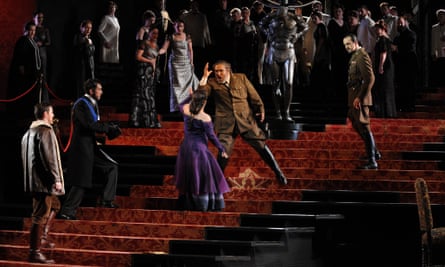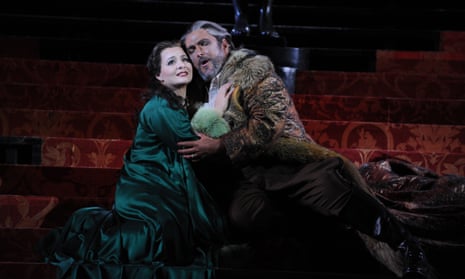In an attempt to entice composer Giuseppe Verdi out of premature retirement in the late 1800s, Italian librettist Arrigo Boito wrote his own version of Shakespeare’s Othello. It stripped the narrative so that the action centred predominantly on its four main characters. As a result, Verdi’s penultimate opera, Otello, is not only one of Verdi’s most character-driven works, it is also one of his most focused and beloved.
Otello was first directed by German director Harry Kupfer for Opera Australia in 2003, who updated the work from 15th century Cyprus to wartime Germany. In this remount the set, by original designer Hans Schavernoch, retains its visually arresting grand staircase with its tilted, crumbling edge, and swastikaesque red cross. Similarly, the costumes preserve their symbolic allure, the sumptuous black and white evening attire of the chorus contrasting with the jewelled tones of Desdemona’s emerald and purple evening gowns.
Revival director Roger Press stages Kupfer’s original direction slickly, with thrilling vocal work by the chorus in the opening scenes of the storm and some striking tableaux. But it is the lead performances of these tragic characters that really make the night.

Lianna Haroutounian, stepping in for disgraced Georgian soprano Tamar Iveri, does an admirable job of Desdemona. Considering the speed of her acquisition (Iveri was released from her contract after posting homophobic remarks on her Facebook page two weeks ago), her love duet at the end of Act 1 with Otello and her Willow Song are tender and strong.
As for Otello, the New Zealand tenor Simon O’Neill commands from the minute he steps on stage. From his re-entry in Act 1 where he seeks to silence the fray ("Abbasso le spade!"/"Down with your swords!"), O’Neill’s vocal and physical presence never wavers. Taught the role by one of the great Otellos, Placido Domingo, and fresh from a season of Wozzeck at the Metropolitan Opera, it is with single-minded intensity that O’Neill’s Heldentenor pierces through the psyche of the beleaguered Moor.
But perhaps it is Italian baritone Claudio Sgura as Iago who is the most enigmatic of the three. From his early interactions with lovesick Roderigo (David Corcoran) and newly appointed captain Cassio (James Egglestone), it’s easy to see why, besides wanting to distinguish it from Gioachino Rossini's Otello, Verdi initially wanted to name the opera after the scheming adversary. In Act 2 where Sgura – long-haired, long-limbed and lean – sings the famous "Cassio’s dream" arietta, his baritone is so light and benignly tempered that the audience too is almost persuaded of Desdemona’s infidelity.
Once read as an argument for miscegenation, Otello remains as powerful as its first performance in Milan over a hundred years ago. It would be foolish of Opera Australia not to put on this production a hundred times more.

Comments (…)
Sign in or create your Guardian account to join the discussion